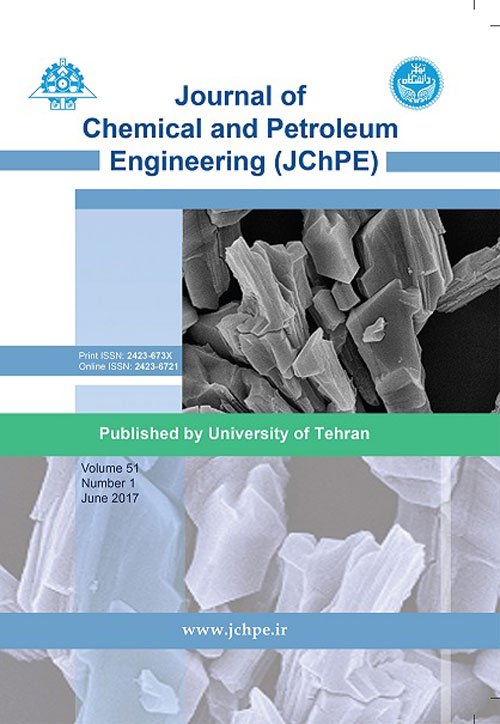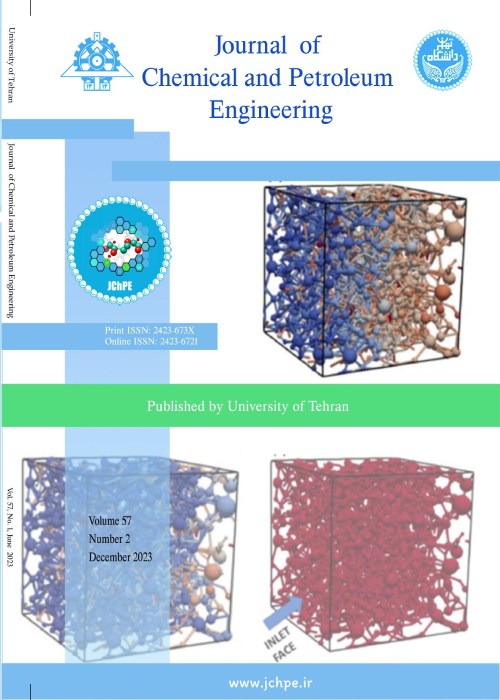فهرست مطالب

Journal of Chemical and Petroleum Engineering
Volume:51 Issue: 1, Jun 2017
- تاریخ انتشار: 1396/05/07
- تعداد عناوین: 8
-
-
Pages 1-7Geometric programming is a mathematical technique, which has been developed for nonlinear optimization problems. This technique is based on the dual program with linear constraints. Determination of species concentrations in chemical equilibrium conditions is one of its applications in chemistry and chemical engineering fields. In this paper, the principles of geometric programming and its computational method are presented. Also, for a chemical equilibrium, as an example, the concentrations of species for the ammonia synthesis reaction are determined. The obtained results are compatible with the experimental data available in the literature. This leads to the application of the geometric programming to estimate the concentrations in the equilibrium conditions for reactions where the experimental data are not available.Keywords: Chemical equilibrium, Gibbs free Energy, mathematical modeling, optimization
-
Pages 9-19In this paper, a mathematical model is developed to calculate the conversion and the residence time reaction for plug flow and mixed flow in the reactors filled with cylin-drical particles using the shrinking core model. In this modeling, the size of the particles is un-chamged during the reaction. Also, the reaction rate is controlled by the gas layer resistance, the ash layer resistance, and the reaction resistance as well as the combination of them. In addition, it is assumed that the gas diffuses radially from the side, whereas the effect of diffusion in the axial direction is neglected. Equations are solved by numerical methods. It can be said that the innovation of this paper is the study of the effect of combination of resistances on the conversion of the reaction. Model evaluation shows that the results of modeling have a good consistency with the experimental data. The results show that at a certain time, when the rate of reaction is controlled by each of the resistances individually, the conversion rate is greater when the reaction is controlled by the ash layer resistance than when it is controlled by the other two resistance regimes. Finally, the effect of the combination of different controlling regimes on the conversion and residence time of reaction for plug flow and mixed flow of particles is studied and it is found that the overall results are similar to each other.Keywords: Gas-solid reactions, Shrinking Core Model, Cylindrical particle, Conversion, Residence time, Combination of resistances
-
Pages 21-26In this paper, porous metal−organic frameworks (MIL-53 [CrIII (OH).{O2C-C6H4-CO2}.{HO2C-C6H4-CO2H}x]) were hydrothermally synthesized and, then, a hybrid composite of these synthesized porous metal−organic frameworks (MOF) with acid-treated multi-walled carbon nanotubes (MWCNTs) was prepared. The materials were characterized by X-ray diffraction (XRD), scanning electron microscopy (SEM), BrunauerEmmetTeller (BET), and FT-IR analysis. The X-ray diffraction patterns showed that the structure of MWCNT@MIL-53-Cr nonoporous composite was not disturbed by incorporation of MWCNT in MIL-53-Cr. N2 adsorption desorption analysis showed that the MIL-53-Cr and MWCNT@MIL-53-Cr nanoporous composite had BET surface areas of 1500m2.g-1 and 1347m2.g-1, respectively. These materials were developed as adsorbents for methane storage at room temperature. The analysis showed about 50% increase in methane storage capacity (from 7.1 to 10.8 mmol.g-1 at 298K and 35bar) for MWCNT@MIL-53-Cr composite. The increment in the CH4 adsorption capacity of MWCNT@MIL-53-Cr nanoporous composite is attributed to the increase in micropore volume of MIL-53-Cr by MWCNT incorporation.Keywords: Metal organic framework, MIL-53-Cr, MWCNT, Acid-treated, CH4 storage
-
Pages 27-37Type of packings and characteristics of their geometry can affect the flow behavior in the reactive distillation columns. KATAPAK SP is one the newest modular catalytic structured packings (MCSP) that has been used in the reactive distillation columns, recently. However, there is not any study on the hydrodynamics of this packing by using computational fluid dynamics. In the present work, a 3D VOF model was developed to evaluate dry and wet pressure drops of catalytic structured packings, MCSP-11 and 12. The module of MCSP is made of alternating vertical layers of structured packing sheets (Mellapak Plus) and catalyst bags. The goal of this paper is to illustrate the effect of geometry on the hydrodynamics and characterization of flow in the MCSP modules. Results showed that the mean relative errors for prediction of dry and wet pressure drops were 17% and 7% for MCSP-11 and 11% and 12% for MCSP-12, respectively. According to CFD results, pressure drop in closed channels was higher than that in open channels. The catalyst bags were simulated as porous media. The simulation led to determination of the liquid velocity distribution in the catalyst bags.Keywords: Reactive separation, Modular catalytic structured packing, Mellapak Plus, Multiphase model, Hydrodynamic, computational fluid dynamics
-
Pages 39-45Engine oils are widely used for lubrication purposes in automobile and related industries. Viscosity Index (VI) improver has found its largest commercial applications as additives to engine oils. Examples are power steering fluid, aircraft piston engine oils, modern internal-combustion engines, turbine engine oils (stationary and aircraft), and industrial gear oils. Viscosity Index improvers are added in the lube oils to reach the desired Viscosity Index (VI). The enhancement of VI of lube oils (Servoneum 100, Servopress 68, Servomesh SP 220, and Servocut 335) by the addition of viscosity index improvers (Methylmethacrylate (MMA), Polybutadiene rubber (PBR), and Polyisoprene-cis) has been studied. VI of blended oils, made from the lube oils (Servoneum 100, Servopress 68, Servomesh SP 220, and Servocut 335) by the addition of MMA, PBR, and Polyisoprene-cis, has shown the potential to reach the maximum value. It has been found that the occurrence of maximum VI depends on the lube oil used and the type and concentration of viscosity index improver.Keywords: Lube oil, Methylmethacrylate, Polybutadiene rubber, Polyisoprene-cis, VI improvers, Viscosity index
-
Pages 47-53In the process of crude oil desalination, the aim is to separate dispersed phase of brine from oil phase. The project aim is the use of carbon nano-adsorbent for remov-al of salt from crude oil that, unlike other methods of salt separation from crude oil currently used, is a simple, inexpensive method with good ability to remove salt from crude oil. In this study, first, four types of carbon adsorbent were used for removal of salt from crude oil using dispersion in solution method. Then, the adsorbents that had the best absorption were identified. In continuation, two nano-adsorbents were selected from nano-adsorbents and their effect on the absorption of salt from crude oil was investigated using filtration method. Finally, a survey was carried out on regeneration of multi-walled carbon nanotubes that had the ability to absorb more than 50% of salt from crude oil, which were then selected as the best nano-adsorbents.Keywords: crude oil, Desalting, Nanocarbon, regeneration, adsorbent
-
Pages 55-67Most of the Iranian oil and gas wells in the Persian Gulf region are producing through their natural productivity and, in the near future, the use of stimulation methods will be undoubtedly necessary. Hydraulic fracturing as a popular technique can be a stimulation candidate. Due to the absence of adequate research in this field, numerical simulation can be an appropriate method to investigate the effectiveness of hydraulic fracturing. In the current study, the hydraulic fracturing process is simulated for a wellbore in the Persian Gulf region with Abaqus software. The main parameters that are necessary for the simulation are collected through wellbore logs and core tests. Fracturing process is studied with more emphasis on the pressure of fracturing fluid and fracture opening. Finally, several 3D fluid-solid coupling finite element models are generated and the main obtained results are compared.Keywords: Hydraulic Fracturing, Finite Element Method, Persian Gulf, Abaqus, 3D fluid-solid model
-
Pages 69-80The main disadvantage of biodiesel is its high price. The price of biodiesel depends on various factors such as the price of oil, methanol, catalyst, and labor. Among dif-ferent economic factors, oil accounts for the largest share of input costs of biodiesel production. In this study, first, suitable heterogeneous catalysts were identified for biodiesel production. Several studies were carried out on biodiesel production using heterogeneous catalysts. All of these studies were designed to confirm that the pro-duction of biodiesel was cheaper than that of petroleum diesel. Waste materials as feedstock were used for this purpose. In transesterification reaction, waste cooking oil and waste materials were used as catalysts. Alkaline earth metal oxides catalysts are the best kind of heterogeneous catalysts. The catalytic reactivity of alkaline earth metal oxides including waste source of calcium oxide and magnesium oxide, CaO/Al2O3, CaO/SiO2, BaO/SiO2, and MgO/SiO2 were evaluated by the transesterification of oil and methanol. In this study, the costs of produced biodiesel were compared for different sources. The results indicated that the cost of produced biodiesel using synthetic catalysts was 1.26 to 1.49 times that using natural catalysts (1.26 and 1.49 are related to waste cooking oil and refined oil, respectively). Consequently, using waste cooking oils and natural catalysts is recommended for biodiesel production. Also, n-hexane as co-solvent was used to increase the solubility of methanol in oil. In presence of n-hexane, the cost of biodiesel production was approximately reduced by 16%.Keywords: Basic heterogeneous catalysts, Biodiesel, economy, Waste catalyst, Waste cooking oil


